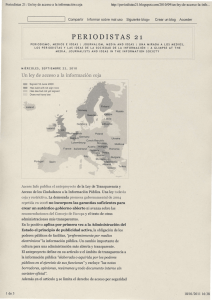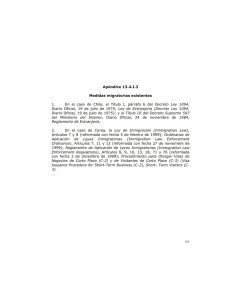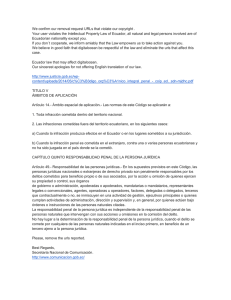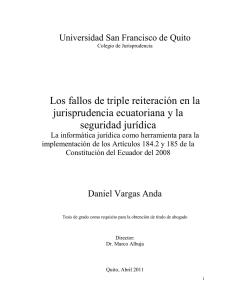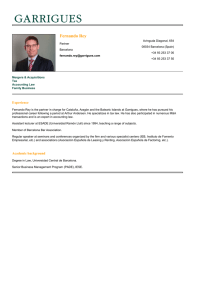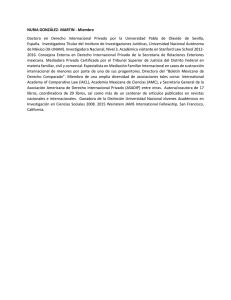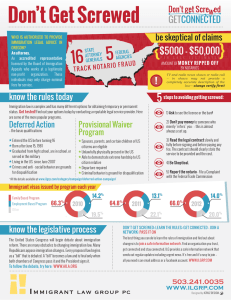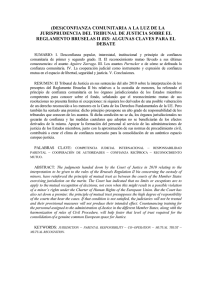Journal of Inter 䀘 - Shepard Broad College of Law
Anuncio
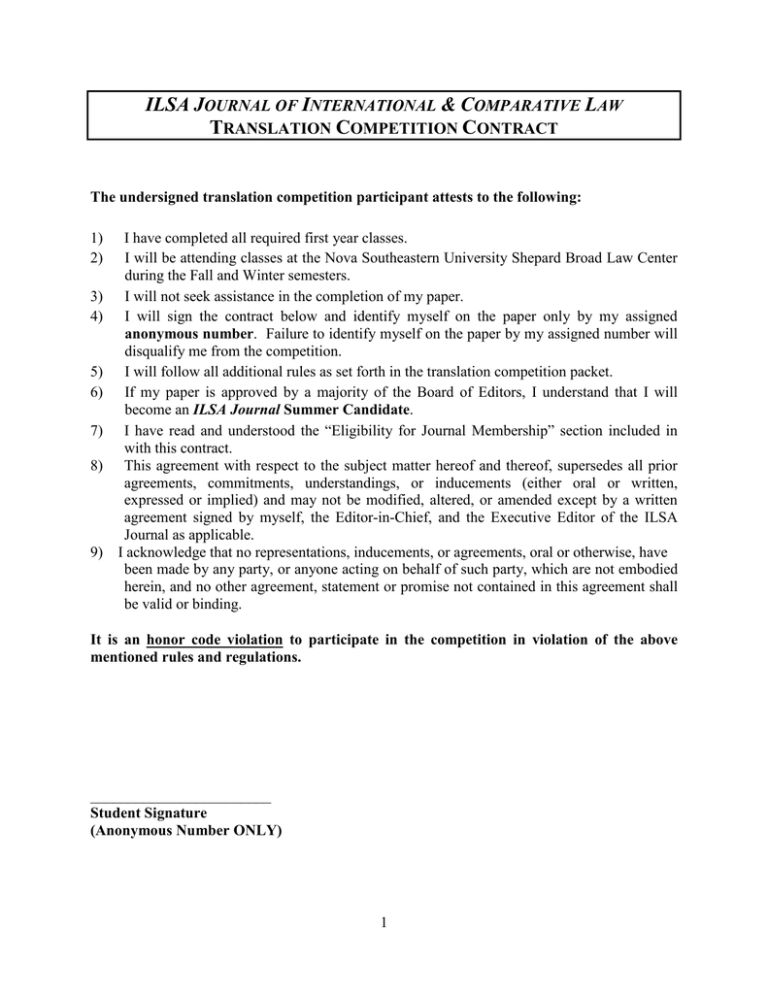
ILSA JOURNAL OF INTERNATIONAL & COMPARATIVE LAW TRANSLATION COMPETITION CONTRACT The undersigned translation competition participant attests to the following: 1) 2) 3) 4) 5) 6) 7) 8) 9) I have completed all required first year classes. I will be attending classes at the Nova Southeastern University Shepard Broad Law Center during the Fall and Winter semesters. I will not seek assistance in the completion of my paper. I will sign the contract below and identify myself on the paper only by my assigned anonymous number. Failure to identify myself on the paper by my assigned number will disqualify me from the competition. I will follow all additional rules as set forth in the translation competition packet. If my paper is approved by a majority of the Board of Editors, I understand that I will become an ILSA Journal Summer Candidate. I have read and understood the “Eligibility for Journal Membership” section included in with this contract. This agreement with respect to the subject matter hereof and thereof, supersedes all prior agreements, commitments, understandings, or inducements (either oral or written, expressed or implied) and may not be modified, altered, or amended except by a written agreement signed by myself, the Editor-in-Chief, and the Executive Editor of the ILSA Journal as applicable. I acknowledge that no representations, inducements, or agreements, oral or otherwise, have been made by any party, or anyone acting on behalf of such party, which are not embodied herein, and no other agreement, statement or promise not contained in this agreement shall be valid or binding. It is an honor code violation to participate in the competition in violation of the above mentioned rules and regulations. ________________________ Student Signature (Anonymous Number ONLY) 1 ILSA Journal of International & Comparative Law TRANSLATION COMPETITION PACKET Nova Southeastern University Shepard Broad Law Center Journal of International & Comparative Law 3305 College Avenue Fort Lauderdale, FL 33314 (954) 262-6005 2 TABLE OF CONTENTS I. INTRODUCTION ..................................................................................................................... 4 A. Eligibility for Journal Membership............................................................................ 4 B. Limitation as to Materials and Sources ..................................................................... 4 C. Technical Requirements .............................................................................................. 5 D. Evaluation of Your Paper............................................................................................ 5 II. HONOR CODE OATH ........................................................................................................... 5 III. GENERAL INSTRUCTIONS............................................................................................... 6 A. Additional Sources ....................................................................................................... 6 IV. EXCERPTS TO TRANSLATE ............................................................................................ 7 3 I. INTRODUCTION Congratulations on your decision to participate in the ILSA Journal of International & Comparative Law translation competition. In this packet you will find all the necessary materials for the translation competition paper. Check that the materials listed in the Table of Contents have in fact been included in your packet. A. ELIGIBILITY FOR JOURNAL MEMBERSHIP Fully complete and sign the above contract by using your anonymous number ONLY. Failure to expressly agree to the terms of the competition will result in your not receiving an invitation regardless of the quality of your paper. Translation competition participants must have a cumulative grade point average of 2.50, and must have completed all first year courses in order to be eligible for Journal membership. Since you may not have this information at this time, verification through student services will take place after you have submitted your paper. If your translation paper is accepted by a majority vote of the Journal’s Board of Editors, you will be eligible to participate in the Journal Summer Candidacy Program. To become a junior staff member of the Journal, you must successfully complete the summer candidacy program by choosing one of the two options. If you choose the first option, you will be required to write a 20-25 page scholarly article of publishable quality on a topic of international law. If accepted, this paper can be used to meet NSU's writing requirement and can further be submitted for publication. Alternatively, if you choose the second option, you will be required to write a 10 page paper on a topic of international law. This paper, however, cannot be submitted for publication and cannot be used to satisfy NSU's writing requirement. Additionally, you will be required to attend three (3) mandatory sessions over the summer. Dates will be released upon invitation to the Summer Candidacy Program. These three sessions are mandatory and must be attended in order to complete the summer candidacy program. If you successfully meet the summer candidacy program requirements, you will be extended an offer to be a junior staff member of the Journal. As part of your obligations as a Journal member, you will also be required to enroll in one international legal course before graduating from Nova Southeastern University. B. LIMITATION AS TO MATERIALS AND SOURCES The rules of the translation competition require that you strictly limit yourself to the materials and sources contained and indicated in this packet when translating the material. Refer to section III (A) below as to additional permitted sources. It is an honor code violation to confer with anyone on this assignment, or to use sources other than the ones allowed in this packet. The use of translation software, either online or offline, is strictly prohibited. 4 C. TECHNICAL REQUIREMENTS 1. TYPING/PRINTING: All translated papers must be typed on white 8 1/2 x 11 paper using double-spacing for text. Your paper should be fully justified. All margins should be one inch. Each page should be numbered on the bottom center starting with page one of the text. The font size must be twelve characters per inch. The Journal recommends using Times New Roman (12 font). 2. PAGE LENGTH: There is no set maximum of pages. You must translate the entire excerpt that was given to you. Incomplete translations will NOT be considered. 3. TITLE PAGE: Papers are to be submitted anonymously. The title page may only contain the title of your paper, (e.g. “STATE AND LOCAL REGULATION OF IMMIGRATION: THE NEED FOR A BILATERAL (RECIPROCAL) RATCHET”), and your anonymous number. The title page information may not be incorporated into the first page of the text. D. EVALUATION OF YOUR PAPER Members of the Journal Board of Editors (Bilingual Team) will evaluate each paper individually. The Journal is looking for work that demonstrates the ability to write in a scholarly legal manner within the structure of the translation competition. Scholarly legal writing exhibits a high degree of legal analysis, writing style, organization, and attention to technical detail (i.e., correct spelling, punctuation, grammar, and citation form). The Journal is looking for individuals who pay attention to detail, meet deadlines, follow instructions and demonstrate fluency in the Spanish and English languages. Most importantly, while you attempt to translate the article, do not lose focus of the original intent of the author. In evaluating your paper, the editors will not be looking for a verbatim translation. Rather, they will evaluate you on your ability to retain the intent of the author. All papers will be evaluated anonymously; you must not identify yourself in your paper by any means other than by the anonymous number. If your paper receives a majority vote of the Board of Editors, you will become a Journal Summer Candidate. II. HONOR CODE OATH Translation competition participants shall neither seek nor receive aid relating to preparing, researching, or writing their papers from any other source other than those listed in the Competition Packet. Unauthorized help includes, but is not limited to: 1. 2. 3. 4. Discussion with any Journal member, write-on competitor, candidate, or editor. Discussion with faculty members or other law students. Discussion with family, friends, or legal practitioners. Use of any computer software program, other than a spelling checker, grammar, or word choice. 5 Violation of this policy will terminate the consideration of an individual’s candidacy for membership on the Journal, and may result in an honor code complaint being filed against you. III. GENERAL INSTRUCTIONS This section lists all materials that may be used for the completion of your paper. You are required to translate 2 excerpts, one from English into Spanish and one from Spanish into English. The excerpts begin on page 9 of this packet. You must properly insert and translate all footnotes in the corresponding place of your Spanish version. The translated footnotes must conform to Bluebook rules on translation (titles and names of documents in languages other than the document’s language). Your finished product should read smoothly with proper verb conjugations and proper tenses. Each candidate is responsible for insuring that they have a complete packet. A. ADDITIONAL SOURCES You may use only the following sources: 1. Law dictionaries (i.e., Black’s, Ballentine’s). 2. Dictionaries of the English language (i.e., Webster’s) and dictionaries of the Spanish language. 3. Bilingual dictionaries, including bilingual legal dictionaries. 4. A thesaurus. 5. A reference book on legal writing and style (i.e., The Chicago Manual of Style, Writing and Analysis in the Law). 6. The Bluebook 7. Official web sites of the U.N. with the limitations indicated below. **The use of translation software, either online or offline, is strictly prohibited. U.N. Official Web sites: Participants in the translation competition may consult the UN official website SOLELY for the purpose of obtaining the name of a particular UN document (treaty, convention, protocol, etc.) in the Spanish language, if such document is available in Spanish. The Spanish names of UN documents may also be accessed from other UN-related websites by choosing the Spanish language option. For example, you may directly access the website for the United Nations Conference on Trade and Development (www.unctad.org) and click on the Spanish option to obtain the name of a pertinent document, if available, in the Spanish language. Participants are prohibited from consulting or accessing the above-mentioned websites, and documents therein found, for purposes of translating text other than the name of a UN document. If the English article contains a provision directly quoted from a UN document that is available in Spanish, do not consult the text of the document. The translation of such quoted provisions must be the participant’s own work and the general rules for the translation competition apply. 6 If after diligent search a participant is unable to find the official Spanish name for a UN document, or such a name is not available, then a candidate must make a good faith effort to translate the document name as accurate as possible in the Spanish language. IV. SAMPLE EXCERPTS TO TRANSLATE EXCERPT TO TRANSLATE (ENGLISH TO SPANISH) STATE AND LOCAL REGULATION OF IMMIGRATION: THE NEED FOR A BILATERAL (RECIPROCAL) RATCHET I. INTRODUCTION Part I of this essay briefly outlines the historical debate regarding the federal regulation of immigration, the federal preemption standard and then analyzes recent cases focused specifically on preemption. Part II of this essay focuses on several subfederal regulations passed or proposed in Nebraska in 2010 and 2011 that are reflective of the greater debate raging nationwide. Finally, in light of three recent Supreme Court actions, Part III of this paper proposes a more progressive analysis regarding state and local regulation of immigration in order grant states the ability to create and implement immigrant-positive legislation. 1 Part III suggests a more flexible approach based partially on immigrant access to certain essential rights including employment, housing, transportation, education, and public services. The article concludes that a more progressive, pro-immigrant approach will level the legislative playing field and best serve state and federal interests in regulating immigration. II. THE DEBATE OVER PREEMPTION IN IMMIGRATION In May 2011 the Supreme Court announced its decision in Chamber of Commerce of the United States v. Whiting 2 upholding Arizona’s 2007 law that allows the appropriate authorities in the state to suspend or revoke certain business licenses for those businesses who “knowingly or intentionally employ” unauthorized immigrants. 3 The primary reason for upholding the law was the express language in the statute that allows states to impose sanctions “through licensing and similar laws” (hereinafter the “Savings Clause”) which have generally been regarded as traditional spheres of state regulation. 4 Whiting must also be read in the context of the past thirty 1. As it stands, the Whiting decision is at least partially at odds with the holdings in cases such as the Third Circuit’s decision in Hazleton and the United States District Court for the Northern District of Texas’ decision in Villas at Parkside Partners v. Farmer’s Branch. See Hazleton, Pa., 131 S. Ct. at 2958; Villas at Parkside Partners, et al. v. City of Farmer’s Branch, Tex., 701 F. Supp. 2d 835,835 (N.D. Tex. 2010). Since 8 U.S.C. § 1324a(h)(2) contains a savings clause that only benefits increased enforcement regulations, the current statutory regime is, by its nature, pro-enforcement. A more flexible approach towards state regulation could at least allow more inclusive proposals. See 8 U.S.C. § 1324a(h)(2) (2006). 2. Whiting, 131 S. Ct. at 1973. 3. ARIZ. REV. STAT. ANN. §§ 23-211, 212, 212.01 (West 2010). This law is not to be confused with the more infamous Ariz. S.B. 1070 which is much broader in scope and purpose, and which has, as of this written, been partially enjoined by the District Court of Arizona. See Ariz. S.B. 1070. See also U.S. v. Arizona, 703 F. Supp. 2d 980 (D. Ariz.). 4. 8 U.S.C. § 1324a(h)(2). 7 years of immigration-related preemption analysis which appears to be trending away (albeit) not uniformly so) from a broad, robust preemption framework. 5 In turn, all immigration-related preemption analysis needs to be viewed in light of the historic trends regarding preemption analysis in general. a. Preemption Defined A brief recap of federal preemption law is necessary to understand its constitutional underpinnings prior to focusing in on immigration-specific application of the doctrine. Under federal law, there are generally two types of preemption: express and implied, and both types arise from either the Supremacy Clause of the U.S. Constitution or from language in a federal statute declaring preemptive effect. 6 Simply stated, the Supremacy Clause prohibits any subfederal laws that “interfere with or are contrary to” federal law, 7 whereas express preemption occurs when Congress, through statute, has explicitly held that any related subfederal laws are displaced. 8 In contrast to express preemption, implied preemption can occur in one of two ways: field preemption or conflict preemption. One way in which field preemption occurs is where federal law is so extensive in an area as to have been deemed to occupy a given subject matter exclusively.9 In those situations where federal law is “so pervasive as to make reasonable the inference that Congress left no room for the States to supplement it,” subfederal laws will be struck down even if not in direct conflict with the federal statute at question. 10 Other techniques that courts have used to find field preemption is whether “the federal interest in the field is sufficiently dominant” 11 and whether “the object sought to be obtained by the federal law and the character of obligations imposed by it reveal the same purpose.” 12 The other type of implied preemption is conflict preemption. 13 Conflict preemption exists where a subfederal law “stands as an obstacle to the accomplishment and execution of the full purposes and objectives of Congress,” or it is not possible for a party to comply with both the federal and subfederal law simultaneously. 14 An immigration-related example would be localities enacting sanctuary-type ordinances to prevent or disrupt the removal of unauthorized immigrants. 15 5. See infra notes 32–40 and accompanying text. 6. U.S. CONST. art. VI, cl. 2. See also English v. General Elec. Co., 496 U.S. 72, 78 (1990) (stating “Congress can define explicitly the extent to which its enactments preempt state law”) (citing Shaw v. Delta Air Lines, Inc., 463 U.S. 85, 95–98 (1983)). 7. U.S. CONST. art. VI, cl. 2; English, 496 U.S. at 78. 8. English, 496 U.S. at 72. 9. Rice v. Santa Fe Elevator Corp., 331 U.S. 218, 230 (1947). 10. Rice, 331 U.S. at 230. 11. Schneidewind v. ANR Pipeline Co., 485 U.S. 293, 300 (1988). 12. Rice, 331 U.S. at 230. 13. See, e.g., Hines v. Davidowitz, 312 U.S. 52 (1941) (showing that one of the early conflict preemption cases happens to be immigration related). In 1939, Pennsylvania attempted to adopt an alien registration act requiring an identification card which the U.S. Supreme Court ultimately held was superseded and preempted by the federal Alien Registration Act which contained no identification card requirement. See id. at 74. 14. Hines, 312 U.S. at 67. 15. See generally United States v. Merkt, 794 F.2d 950 (5th Cir. 1986). 8 III. IMMIGRATION-RELATED PREEMPTION a. Historic Roots of Preemption One reasonable conclusion after reviewing immigration-related preemption analysis is that it strongly resembles the path of a river in that it has shifted dramatically and often unpredictably over time. Prior to discussing preemption; however, it is first necessary to get to the underlying authority to legislate. On that note, for the better part of the first one hundred years of the United States, immigration law was largely ignored on a federal level. 16 It was not until the late 1800s and the foundational cases of Chae Chan Ping v. United States (The Chinese Exclusion Case), Fong Yue Ting v. United States, Ekiu v. United States, Henderson v. Mayor of City of New York, and Chy Lung v. Freeman that the Court acknowledged, quite forcefully, Congress’ plenary and exclusive role in immigration. Following those cases and the need that some commentators have identified for uniform immigration laws and enforcement, 17 it becomes apparent that a preemption challenge could easily lurk in the background anytime a state or locality were to pass a law related in some manner to immigration. That the potential for a preemption challenge exists in nearly all cases of subfederal regulation has not led to the ultimate conclusion that these statutes and ordinances are therefore preempted and unenforceable. 18 In fact, some principled distinctions have arisen. In arguably the seminal case of modern preemption analysis for immigration law, the Court in De Canas v. Bica held that “the fact that aliens are the subject of a state statute does not render it a regulation of immigration, which is essentially a determination of who should or should not be admitted into the country, and the conditions under which a legal entrant may remain.” 19 The Court noted “there would not appear to be a . . . federal interest in a situation in which the state law is fashioned to remedy local problems, and operates only on local employers, and only with respect to [those] individuals” the federal government has deemed unauthorized to work in the country. 20 Even though statutorily overruled with the enactment of the Immigration Reform and Control Act (IRCA), 21 the essential holding in De Canas that laws that affect immigrants are not necessarily laws regulating immigration was not overturned. 22 Indeed, other scholars have already observed some modern courts’ reluctance to utilize implied theories of preemption where possible. 23 Lawmakers and advocacy groups alike have latched on to preemption analysis and tea-leaf reading in an effort to enact or oppose local laws. 24 16. See generally John Higham, American Immigration Policy in Historical Perspective, 21 LAW & CONTEMP. PROBS. 213 (1956). 17. See Huyen Pham, The Inherent Flaws in the Inherent Authority Position: Why Inviting Local Enforcment of Immigration Laws Violates the Constitution, 31 FLA. ST. U. L. REV. 965, 1003 (2004). 18. See, e.g., Whiting, 131 S. Ct. at 1970 (concluding Arizona’s “Legal Arizona’s Worker’s Act” was not preempted by federal law). See also ARIZ. REV. STAT. ANN. §§ 23-211, 212, 212.01; De Canas, 424 U.S. at 351. 19. De Canas, 424 U.S. at 355. 20. Id. 21. Immigration Reform and Control Act, 8 U.S.C. §§ 1160, 1187, 1188, 1255(a), 1324a, 1324b, 1364, 1365 (1986) (addressing employment of unauthorized immigrants). 22. See Toll v. Moreno, 458 U.S. 1, 17 (1982) (holding a Maryland state university policy that prohibited certain non-immigrants and their dependants from acquiring in-state resident status violated the Supremacy Clause of the U.S. Constitution). 23. See, e.g., Cristina M. Rodríguez, The Significance of the Local in Immigration Regulation, 106 MICH. L. REV. 567 (2008). 24. See Appellant’s Reply Brief at 15–16, Lozano v. City of Hazleton, 620 F.3d 170 (3rd Cir. 2010), Case No. 07-3531, 2008 WL 3989656 (arguing that the ordinances are not expressly preempted by stating that “[a]ppellees go to extraordinary lengths to twist this express permission into an express prohibition, resurrecting a far-fetched theory . . . that 8 U.S.C. § 1324a(h)(2) allows a city to impose licensing sanctions only after the employer has been tried in a federal criminal or civil proceeding and found to violate an IRCA provision”) (citing Appellees’ Brief at 75); Appellants’ Reply Brief at 18, U.S. v. Arizona, 641 F.3d 339 (9th Cir. 2011) (No. 10-16645), 2010 WL 5162517, at *18 (quoting “[n]or can the United States establish conflict preemption merely by demonstrating that there is a difference between state and federal law. The United States has not identified an actual conflict between section 5(C) and federal law 9 b. Modern Immigration Preemption Trends As recent case law has unfolded at a dramatic pace in the latter half of the 2000s, lawmakers have attempted various strategies to minimize the risk of a preemption battle.25 In light of this recent wave of subfederal litigation26 and the 2011 Supreme Court actions on related cases,27 this author believes that another shift in immigration-related preemption is already underway. c. State Regulation on Immigration In 2007, Arizona passed a law requiring employers to use E-Verify 28 to confirm an employee’s work authorization and it also contained penalties in the form of license revocations for employers who were not in compliance with federal prohibitions regarding the employment of unauthorized immigrants. While nowhere near as sweeping as the 2010 Arizona law known as S.B. 1070, the 2007 law was perceived as susceptible to a preemption challenge. 29 As discussed in Part I.A.4.a., in 2011 the Supreme Court rejected the preemption argument for a few, very specific reasons. While newsworthy, the decision in Whiting was not unexpected as both the District Court and the Ninth Circuit had upheld the law, and while the differing policy arguments stressed by Justices Breyer 30 and Sotomayor 31 discussing the delicate balance obtained by IRCA were compelling, they were insufficient to overcome what J. Roberts saw as the plain language of the statute. Interestingly, the preemption battle has not been solely waged by those in favor of proimmigrant legislation. Martinez, where California granted in-state tuition to unauthorized immigrants based on the location of the high school from which they graduated, appears to go further than Whiting in that it arguably allows for state action that is perhaps beyond the language of the statute. 32 The legislation in Martinez was challenged on preemption grounds 33 for violating the federal prescription on benefits for unauthorized immigrants based on residence. 34 In Martinez, arguments for express preemption, conflict preemption and field preemption were unsuccessful in persuading the Court to intervene on preemption grounds and the California Supreme Court was likewise not persuaded that the law was preempted. 35 Reading these cases together36, it would appear the Court is heading toward a narrower interpretation of preemption because the United States has not shown that it was Congress’ purpose to protect unauthorized employees from state sanctions.” (citations omitted)). 25. See, e.g., Utah Illegal Immigration Enforcement Act, H.B. 497. See also supra notes 8, 10–11 and accompanying text. 26. See supra note 7. 27. See Regents of the Univ. of Cal., 131 S. Ct. at 2961; Whiting, 131 S. Ct. at 1968; Hazleton, Pa., 131 S. Ct. at 2958. 28. See ARIZ. REV. STAT. ANN. §§ 23-211, 23-214. E-Verify was officially enacted under the title “Basic Pilot Program” and has been subject to fairly tumultuous treatment in its short history. See Illegal Immigration Reform and Immigrant Responsibility Act of 1996, Pub. L. No. 104-208, §§ 401–05, 110 Stat. 3009, 3009-655 to 3009-666. The law explicitly states that Congress could not mandate its use. 8 U.S.C. §§ 1324a, 1324b. 29. See, e.g., Fawn Johnson, High Court Could Lean Toward States on Immigration, NAT’L J. DAILY (Dec. 9, 2010), available at http://www.nationaljournal.com/high-court-could-lean-toward-states-on-immigration-20101208 (last visited Mar. 17, 2012); Stephen Dinan, U.S. Pushes E-verify for Hires Few Agencies Employ System, WASH. TIMES, Sept. 25, 2007, at 1. 30. Whiting, 131 S. Ct. at 1987–97 (Breyer, J., dissenting) (reasoning, Congress did not intend its ‘licensing’ language to create so broad an exemption, for doing so would permit States to eviscerate the federal Act's pre-emption provision, indeed to subvert the Act itself, by undermining Congress’ efforts 1) to protect lawful workers from national-origin-based discrimination and 2) to protect lawful employers against erroneous prosecution or punishment.). 31. Id. at 1998–2007 (Sotomayor, J., dissenting). 32. See Martinez v. The Regents of the Univ. of Cal., 241 P.3d 855, 861 (Cal. 2010). 33. Brief for Petitioner at **6–8, 16–20, Martinez, 241 P.3d at 855, 2011 WL 549168. 34. See Martinez, 241 P.3d at 860. See also, 8 U.S.C. § 1623(a) (expressly prohibiting states from providing any post-secondary benefits based on residence). 35. See Martinez, 241 P.3d at 855, cert. denied, 131 S. Ct. 2961 (2011). 36. See Regents of the Univ. of Cal., 131 S. Ct. at 2961; Whiting, 131 S. Ct. at 1970. See also, De Canas, 424 U.S. at 355. 10 than had previously been applied using reasoning similar to that used in De Canas that the regulations, while affecting immigrants, were not regulating immigration. 37 While these two cases alone may not seem to advance De Canas very far, the Hazleton decision as well as the looming battle over S.B. 1070 may continue to see the Court narrowing the preemption battlefield in favor of finding a larger subfederal role in the debate. 38 EXCERPT TO TRANSLATE (SPANISH TO ENGLISH) REGULACIONES ESTATALES Y LOCALES DE INMIGRACIÓN: LA NECESIDAD PARA UN TRINQUETE BILATERAL IV. LEYES Y ORDENANZAS LOCALES CONFIRMADAS En contraste a las decisiones en Hazelton y Farmers Branch, Valley Park fue tratado de manera diferente –al menos en la porción de las ordenanzas del empleador y E-Verify, y esto representa un caso de una ordenanza local toca sobre las regulaciones basadas en inmigrantes que no fue derribada. 39 En Valley Park, después de brevemente reconocer el factor que la presunción en contra del derecho de adquisición preferente aplicaría en este caso, la corte rápidamente resolvió la pregunta de derecho preferente de manera rápida recostándose primordialmente en el lenguaje sencillo del estatuto y de la Cláusula de Ahorros. 40 La corte a la misma vez trabajó similarmente con el campo del argumento de derecho preferente implicado notando que el “requería poca discusión” como la Cláusula de Ahorros evidenció un intento federal para permitir algunas regulaciones de licencias sub-federales. 41 Sin embargo, mientras examinando superficialmente las primeras dos reclamaciones de derechos preferentes, la corte proveyó comentarios extensos sobre el conflicto implicado de derecho preferente. 42 Donde la Corte de Distrito y el Tercer Circuito en Hazelton encontraron numerosos problemas de conflicto potencial entre la ley federal y lenguajes similares en ordenanzas locales separadas, 43 la corte de Valley Park encontró ninguna, pero lo hizo de una manera bastante indirecta. 44 A diferencia de lo que puede ser considerado más como conflictos menores, el área de mayor preocupación en términos de derecho preferente en Valley Park debió de ser el desplazamiento del balance de las cargas establecidas por la IRCA y extendidas por la IIRIRA. En ese aspecto muy poco ha sido dicho en el contexto de derecho preferente como la corte dirigió sus preocupaciones al enmárcalas como basadas en igualdad de protección, y como a eso de 37. Id. 38. See Immigrant Policy Project, supra note 5, at __ (noting the over 1,500 piece of subfederal immigrant-related legislation in the first quarter of 2011, a significant increase over the 2010 numbers). See also, Roger Buddenberg, Immigration Ferment, OMAHA WORLD HERALD 4A, June 10, 2011 (noting that immigration-related bills had been introduced at a rate 30% higher than a year ago). 39. Ver City of Valley Park, 2008 WL 294294, en *10 (afirmando que "la pregunta de la Corte es solamente si la ordenanza es una ley de licencias u otra ley similar".”). 40. Ver id. en *13. 41. Ver id. en *13-*19. 42. Ver supra notas 68-78. 43. Ver City Valley Park, 2008 WL 294294, en *13-*19 (discutiendo argumentos del derecho de prioridad). En respuesta al supuesto conflicto entre la exención federal, que elimina a los trabajadores domésticos de la definición de empleado y la ordenanza de Valley Park, que posiblemente incluiría trabajador doméstico en su definición, el tribunal sostuvo que ". . . la pequeña excepción que se ha creado no es suficiente para crear un conflicto entre la intención del Congreso y la ordenanza local.”Id. en *14. 44. Ver id. en * 19. 11 discriminación, “poca discusión es requerida.” 45 En donde la corte dijo más, sin embargo, fue en el análisis de las provisiones de E-Verify, donde la decisión fue subsecuentemente validada en Whiting. 46 a. Más allá de E-Verify y Empleo: S.B. 1070 y sus Imitadores En el argumento local/nacional, ninguna le ha causado un mayor grito que la S.B. 1070 de Arizona. S.B. 1070 47, preliminarmente ordenado por parte del Tribunal de Distrito de EEUU, 48 pretende a expandir grandemente el desempeño del estado en los asuntos relacionados a la inmigración que requieren refuerzos de leyes locales para participar con oficiales federales, proveyendo una causa privada individual de acción, creando adicionalmente crímenes estatales por empleos (por empleador y empleado) y fallar en cargar los papeles de registro de inmigrantes, aumentando las posibilidades de refuerzos de la ley estatal a determinar el estatus de inmigrantes, y permitiendo arrestos sin orden donde la causa probable existente cree que el inmigrante está presente ilegalmente en los Estados Unidos. 49 El impacto potencial de S.B. 1070, sin embargo decidió, es grande y más allá de lo que se habla en este ensayo en lo que ha sido brevemente mencionado. Mientras la más ofensiva provisión de inmigrantes de la ley fueron derribados en el campo de derecho preferente, los argumentos por el gobierno federal en contestar las leyes fueron enfocadas en el campo implícito del conflicto y el derecho preferente en vez del derecho preferente explícito. Mientras algunas de las provisiones arrejuntadas no suben a el nivel de De Canas de regulaciones de inmigración, ellos aparecen subir claramente al nivel de Hines sobre inferir con o tener un conflicto con un plan integral de inmigración. 50 Entonces, bajo la ley actual, asumiendo que el precedente en Hines continúe a ser válido, S.B. 1070 y leyes similares que traten de expandir la participación de estados y criminalizar el comportamiento ya considerado bajo el marco de regulación federal debe continuar a ser derribado. 51 El problema, claro esta, es que los estados continúan a actuar a favor de la aplicación sin oportunidades de verificar y no siendo compensatorio para existir más estados simpáticos. La trilogía de las decisiones del 2011 agudiza el enfoque de la actual ley de derecho preferente, pero sigue dejando desbalanceado el lado de la aplicación de refuerzo. b. 2011: La Corte Suprema Actúa Antes del verano de 2011, era suficientemente fácil reconocer los variantes resultados que ocurrieron en las seguidas batallas de derechos preferentes en Hazleton (Tercer Circuito), Farmers Branch (Quinto Circuito), Escondido (Noveno Circuito), Arizona (Noveno Circuito) y Oklahoma (Décimo Circuito) como el origen de la sana división de los circuitos. 52 Pero, dado el tres por ciento de las acciones de la Corte Suprema, al menos algunas de las divisiones están 45. Ver id. en * 16; ver también Whiting, 131 S. Ct. at 1968. 46. Ariz. S.B. 1070. 47. Ver Arizona 703 F. Supp. 2d at 1008, afirmado 641 F.3d 339 (9th Cir. 2011). 48. Ver, por ejemplo, ARIZ. REV. STAT. ANN. §§11-1051 et al., 13-1509, 13-2319, 13-2928, 13-2929, 13-3883, 23-212, 23-214 (2010) (West). 49. Ver Arizona 703 F. Supp. 2d en 999. 50. De hecho, la nueva ley de Georgia ya ha sido ordenada por el gobierno federal. Ver Ga. Latino Alliance for Human Rights v. Deal, 793 F. Supp. 2d 1317, 1322 (N.D. Ga. 2011) (concediéndole al demandante un mandamiento judicial preliminar). 51. Ver Lozano, 620 F.3d at 170; Villas at Parkside Partners, 701 F. Supp. 2d en 835; Garret, 465 F.Supp.2d en 1043; Arizona, 641 F.3d en 339; Edmondson, 594 F.3d en 742. 52. Ver Regents of the Univ. of Cal., 131 S. Ct. en 2961; Whiting, 131 S. Ct. en 1970; Hazleton, Pa., 131 S. Ct. en 2958. 12 siendo resueltas. 53 c. Cámara de Comercio de los Estados Unidos v. Whiting Primero, debemos de comenzar con una discusión descriptiva de cualquier división que Whiting sí resuelve. Mientras se reafirma la decisión del Noveno Circuito por un margen de 53, 54 la Corte afirmó los derechos de Arizona para proclamar leyes de concesión de licencias que, pero por la Cláusula de Ahorros, tuviese que de otra manera ser manejadas bajo las leyes federales de inmigración. 55 No sorprendentemente, la Corte se basó en gran medida en el lenguaje de De Canas, el cual notó que los “Estados poseen un autoridad amplia bajo sus poderes políticos para regular las relaciones de empleo para proteger a los trabajadores dentro del Estado,” y eso previene empleos no autorizados “está ciertamente dentro de la corriente principal del poder política [del Estado] . . . .” 56 De cierta importancia los resultados de Whiting es que Arizona defirió a la determinación gobierno federal sobre si un inmigrante está autorizado o no para empleo antes de imponer sanciones en la forma de suspensión o revocación de licencia, y adoptaron grandemente la definición federal de “licencia” y defirieron a las determinaciones federales sobre el estatus de inmigración. 57 Mientras notaban la definición de“licencia” 58 a la interpretación de la Cláusula de Ahorros, la Corte encontró que el estatuto de Arizona, de manera de “sentido común” cae bajo esa definición. Como se esperaba, la Corte afirmó que la decisión del Noveno Circuito que la ley de concesión de licencias sí caía bajo la Cláusula de Ahorros bajo el lenguaje sencillo. Sin embargo, mientras más interesante el asunto sobre si, aunque asumiendo la aplicabilidad de la Cláusula de Ahorros, habría áreas implicadas sobre derecho preferente dado el poder pleno sobre inmigración y, que algunos analistas han argumentado, la necesidad por uniformidad. 59 V. CONCLUSIÓN No es frecuente que personas participando en un debate apasionado se encuentren en un momento de definición tan importante. Con el desorden en las leyes de prioridad en inmigración y los intentos subfederales para entrar en el campo, nosotros nos encontramos en dicha 53. Ver Whiting, 131 S. Ct. en 1968; ver también Nina Totenberd and Ari Shapiro, Kagan Recused From Pending Supreme Court Cases, NPR (29 de Septiembre del 2010), disponible en http://www.npr.org/templates/story/story.php?storyId=130205734 (declarando que J. Kagan se abstuvo de participar en la decisión dado su papel como procurador general antes de su confirmación). 54. Ver Whiting, 131 S. Ct. en 1970 (afirmando que la ley federal de inmigración ahora tiene expresamente derecho de prioridad sobre sanciones civiles o penales impuestas a los empleadores aparte de las que son permitidas por la Cláusula Restrictiva); ver también 8 U.S.C. 8 U.S.C. § 1324a(h)(2)(2006). 55. Whiting, 131 S. Ct. en 1974 (citando De Canas, 424 U.S. en 356, 360.) 56. Ver ARIZ. REV. STAT. ANN.§ 23-211 (2007) (West) (definiendo a un “extranjero no autorizado” como “un extranjero que no tiene el derecho legal bajo la ley federal para trabajar en los Estados Unidos como esta descrito en el titulo 8 del United States Code § 1324a(h)(3)”); ARIZ. REV. STAT. ANN § 23-214 (2007) (West); Whiting, 131 S. Ct. en 1973, 1975, 1982-84. 57. Ver Whiting, 131 S. Ct. en 1978 (afirmando que "la ley de Arizona define la" licencia "como" forma de cualquier permiso emitido por una agencia, certificado, aprobación, registro, carta u otra forma similar de autorización que se requiere por ley y que es emitido por cualquier agencia a los fines de operar un negocio en el estado.” (citando ARIZ. REV. STAT. § 23–211(9)(a)). Además "esta definición se asimila en gran medida a la definición de" licencia "que el Congreso estipula en la Ley de Procedimiento Administrativo.”); ver también 5 U.S.C. § 551(8) (“‘licencia’ incluye la totalidad o una parte de un permiso de una agencia, certificado, aprobación, registro, carta, la pertenencia, la exención legal u otro tipo de permiso”). 58. Ver Whiting, 131 S. Ct. en 1990 (Breyer, J., opinión disidente) (oponiendose a la pérdida de "un esquema de ejecución centralizada”); ver también Pham, supra nota 33. 59. Id. en 1990-92 (Breyer, J., opinion disidente) (resaltando las múltiples formas en que los objetivos contrapuestos, para hacer cumplir las prohibiciones contra la contratación de empleados no autorizados y la limitación de las obligaciones para los empleadores, están equilibrados). 13 encrucijada. Mientras pro-reaccionistas pueden muy bien detestar la propuesta que este artículo sugiere, deberían pararse a reflexionar. Primero, en esos estados deseosos de tener menos inmigrantes, pocos mecanismos pueden haber más efectivos que el hecho de que una jurisdicción vecina proteja el acceso de los inmigrantes a las categorías anteriores. 60 Segundo, la propuesta, aunque pro-inmigrante en sí misma considerada, es neutral en cuanto a anular esquemas legales y sólo busca un campo de juego en que los estados estén puedan actuar. Finalmente, esta propuesta contempla las pasadas tendencias en relación a las economías en depresión y legislaciones anti-inmigrantes al igual que futuras tendencias de rechazo de tasas de nacimiento y escasez de trabajo en una manera en que el estándar actual de legislación no lo hace. Al final parece que la principal supremacía federal y las leyes de regulación de inmigración están llegando a un cierre ya que a los estados y localidades les está siendo otorgado expresamente el derecho de regular. Nosotros deberíamos asegurar que la regulación no sea sólo de un lado, y deberíamos reconocer que es improbable que un trinquete unilateral a favor de la aplicación calme la animosidad de los debates actuales. Proveyendo a los estados y localidades con una voz y un rol, a la vez pro-aplicación y pro-inmigrante, y moldear la legislación actual puede ser la mejor manera de hacer evolucionar el debate cuando se enfrente con la posibilidad real de que ningún esfuerzo exhaustivo federal vaya a aparecer en un futuro cercano. 60. Profesor Spiro, más de una década, pidió un marco del derecho de prioridad para permitir que los estados sean "laboratorios de las mejores prácticas". Ver Spiro supra nota 168, en 1636 n.34. 14
